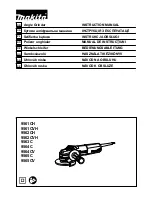
34
p) Checking the centre of gravity
The centre of gravity of the model is preset as a result of the model's
construction and is approximately at the trailing edge of the engine nacelle
stub. When the model is lifted at this point right and left from the fuselage,
it should settle in a horizontal position.
If necessary, the centre of gravity can be shifted by adding lead weight at
the tip of the fuselage or at the tail strike. However, only experienced
pilots should modify the position of the centre of gravity in order to adapt
selectively the model airplane performance to their expectations and
steering habits.
Moving the centre of gravity further towards the back improves the gliding
performance of the airplane but worsens the airplane stability around the
lateral axis. The model then reacts very strongly to the smallest elevator
surface travel.
If the centre of gravity is moved towards the front, the airplane stability
increases at the cost of the gliding performance.
9. Practical Flying Tips
Before starting your model for the first time, you should get information as how to control an airplane model correctly. With your model, the ailerons are visibly
indicated on the wings but they are not connected, flight control is effected exclusively via the elevator and the rudder.
Due to the slightly upward orientated wings, your model will always try, during the flight, to maintain both wing tips on the same level and will adopt a stable flight
attitude around the roll axis.
If you wish to modify a straight flight and to initiate e.g. a left turn, actuate the rudder via the remote control first. Do not push the control lever abruptly but rather
slowly and gently towards the left. Thereupon, the tail of the model (seen in flying direction) is pressed towards the right. The right wing tip moves towards the
front and the left wing tip moves towards the back. Due to the modified current conditions at the wings, the model starts slowly to roll towards the left around the
roll axis. Thereby, it adopts an ever increasing oblique position. If the desired oblique position is reached, reduce the pressure on the control lever so that the
latter can go back to the centre position through the force of the built-in spring.
For an accurate replica flying over a wide area, declinations of up to 20° are perfectly sufficient. For narrow curves, a corresponding bigger oblique
position is necessary.
Due to the slanted wings in relation to the horizon, the model has now a lower lift and will immediately loose height. In order to prevent this, you now should pull
the elevator carefully. If you pull insufficiently, the model will loose height in the curve. If you pull too strongly, the model rises upwards in the curve.
Naturally, you can correct the oblique position of your model while spiralling, thus modifying the curve radius actively. If the curve is too big, increase the oblique
position of your model by regulating the rudder surface travel. If the model adopts an oblique position that is too sharp, then you must immediately counter steer
with the rudder. Thereby, a very big rudder surface travel in the opposite direction might be momentarily necessary.
If your model flies in the desired direction after the curve, then decrease the pressure on the control lever of the elevator so that the control lever can go back to
the centre position. If the model does not correct the still existing oblique position mechanically fast enough, then orientate the model with a brief "rudder push"
into the horizontal position again.
Figure 16
















































